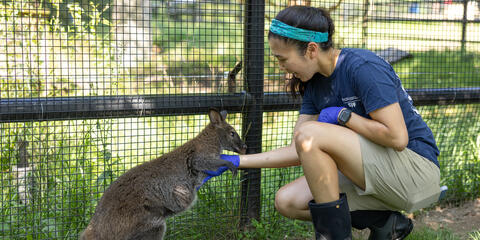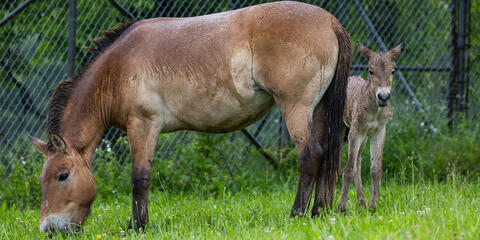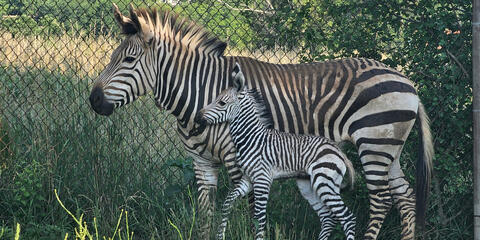Physical Description
Whitish or cream 'spectacles' encircle these bears' eyes. The light color variably extends down to the animals' throats and chests, giving each individual a unique set of markings. Andean bears' thick coats are usually either black or brown, occasionally tinged with red. Each individual spectacled bear has its own distinctive set, or "fingerprint," of distinct cream or whitish markings on its head, throat and chest.
Size
Andean bears grow 5 to 6 feet (1.5 to 1.8 meters) long and stand 2 to 3 feet (0.6 to 0.9 meters) high at the shoulder. Males grow up to 30 percent larger than females, and weigh up to 340 pounds (154 kilograms). Females rarely grow heavier than 180 pounds (81 kilograms).
Native Habitat
Andean bears are South America's only bears and live in the Andes and outlying mountain ranges, from western Venezuela south to Bolivia. A few have been reported from eastern Panama and extreme northern Argentina. Andean bears live in a variety of mountain habitats. Many live between 6,000 and 8,800 feet (1,829 to 2,682 meters) above sea level, although others inhabit lower elevations. Habitat varies from rainforest, cloud forest and mossy, stunted elfin forest to thorny dry forest. They will also forage in grasslands next to forests.
Lifespan
While their average age in human care is around 20 years, it is not uncommon for them to live into their late twenties or occasionally into their early thirties. The Andean bear's longevity in the wild is unknown.
Food/Eating Habits
Fruits and bromeliads are favored foods, but Andean bears also eat berries, grasses, bulbs, cactus flowers and small animals such as rodents, rabbits and birds. Near settlements, bears sometimes raid cornfields.
Andean bears climb trees and forage on the ground. They will build stick platforms to reach elevated food and tear open masses of bromeliads with their sharp claws.
The Smithsonian's National Zoo's Andean bears eat a dry-food mixture (dog chow), plus vegetables, including sweet potatoes and carrots, and fruits such as apples, oranges and grapes.
Sleep Habits
Andean bears are active primarily at night. During the day, Andean bears sleep in secluded spots, such as in tree cavities, on tree platforms, between large, exposed tree roots, or in dens dug into cliff faces.
Social Structure
Outside of breeding season, Andean bears travel alone.
Reproduction and Development
Female Andean bears mature between four and seven years of age. During breeding season, from April to June, males and females stay together for a week or two, mating often. Females experience delayed implantation. This allows the female to give birth during a time when food is abundant—usually between November and February. If there are insufficient resources, the embryo will not implant. Cubs develop for two to three months after implanting. The female gives birth to one or two cubs.
Newborn cubs weigh 10 to 18 ounces at birth, and they are practically bald, toothless and blind. Their eyes generally open at 4 to 6 weeks of age, and they take their first steps soon after. Generally, the cubs do not leave the safety of the den until they are about 3 months old.
Conservation Efforts
Andean bears no longer live in Chile, where they were first described by Western explorers in 1825. However, they can still be found in many parts of their historical range where habitat remains. Habitat destruction and hunting pose the greatest threats to their survival. Poachers sell bear parts to traditional medicine dealers or eat the bear's meat. In addition, people kill bears where they raid cornfields and because they erroneously believe they kill livestock.
In recent decades, spectacled bear numbers declined dramatically in Venezuela, Colombia and Peru. However, healthy populations remain in Ecuador and Bolivia. The Andean bear shares its habitat with many other animals. By protecting Andean bear habitat, conservationists hope to protect these and many other animals, such as the Andean coati, mountain tapir, jaguar and Andean condor.
Help this Species
- Practice ecotourism by being an advocate for the environment when you’re on vacation. During your travels, support, visit or volunteer with organizations that protect wildlife. Shop smart too! Avoid buying products made from animals, which could support poaching and the illegal wildlife trade.
- Support organizations like the Smithsonian’s National Zoo and Conservation Biology Institute that research better ways to protect and care for this animal and other endangered species. Consider donating your time, money or goods.
- Share the story of this animal with others. Simply raising awareness about this species can contribute to its overall protection.
- Less is more. Cut down on the demand for resources by consuming less. Buy only what you need, and look for pre-owned or repurposed items before purchasing something brand new.
Meet the Animals
Quito is a male Andean bear. He was born on Oct. 22, 2013, at Zoo Duisburg in Germany. He came to the Zoo on the recommendation of the Association of Zoos and Aquariums’ Species Survival Plan (SSP) for breeding in Nov. 2017.
In Nov. 2022, Quito and female Andean bear Brienne produced two male cubs, Ian and Sean.
Quito has an easygoing personality. He can often be found sleeping on a pile of hay, sometimes on his back with his feet up in the air.
Want to tell them apart? Quito is considerably larger than the other Andean bears. He has minimal markings on his face.
Brienne is the older of the two female Andean bears. She was born on Jan. 21, 2019, at the Queens Zoo in New York. She has lineage connections to the Zoo: her mother, Nicole, was born here in 2012, and her grandmother, Billie Jean, lived here until 2023. Brienne came to the Smithsonian’s National Zoo in May of 2019 as part of an SSP breeding recommendation.
In Nov. 2022, Brienne and Quito became first-time parents of two male cubs, Ian and Sean, who have since left the Zoo for future breeding opportunities.
Brienne plays with a variety of enrichment toys and puzzle feeders. However, she most prefers cylindrical items, especially PVC tubes, and carries them around in her mouth.
Want to tell them apart? Brienne has a small, tan marking above her right eye.
Suyana is the younger of the two female Andean bears. She was born Dec. 10, 2022, at the San Diego Zoo in California. Suyana also has lineage connections to the Smithsonian’s National Zoo: she is the granddaughter of Chaska, born here in 2010, and the great granddaughter of Billie Jean, who lived here until 2023.
Suyana came to the Zoo as part of an SSP breeding recommendation in November of 2024.
She is spirited and investigative; she enjoys playing with enrichment toys, including a large plastic barrel and water jugs made of thick plastic. Typical for her species, she is a very good climber—she can often be found taking a nap in the trees.
Want to tell them apart? Suyana has a light colored “M” shaped marking above her eyes.
At this exhibit, the Andean bears rotate between habitat yards. Keepers encourage the bears to move between outdoor habitats and indoor dens to ensure every individual gets a chance to spend time outside. You might see a different animal each day you visit!



